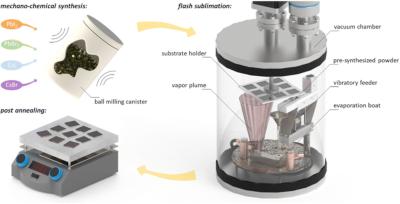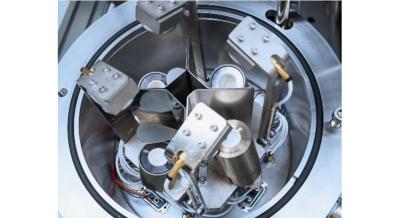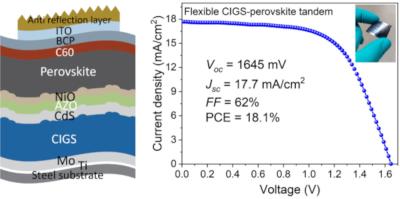Perovskite Solar - Page 21
Researchers develop novel vapor deposition technique based on continuous flash sublimation for rapid fabrication of all-inorganic perovskite solar cells
Researchers at NREL, BlueDot Photonics, University of Washington, Colorado School of Mines and Rochester Institute of Technology have developed a vapor deposition technique based on continuous flash sublimation (CFS) to fabricate all-inorganic perovskite thin films in under 5 minutes in a continuous process. The adoption of the proposed approach may also result in higher power conversion efficiencies of perovskite solar cell.
Schematic illustration of the continuous flash sublimation (CFS) approach consisting of a mechano-chemical synthesis of the source powder (here CsPb(IxBr1−x)3), the high-throughput deposition process in a home-made evaporation system, and a short post-annealing treatment to improve thin-film quality. Image from Journal of Materials Chemistry A
The team described the new technique as a non-batch process that solves two problems associated with the use of established vapor processing in perovskite material manufacturing – the slow speed of deposition and the non-continuous nature of batch processing.
Researchers develop strategy that yields 24.67%-efficiency doctor-bladed perovskite solar cells
Scalable deposition of high-efficiency perovskite solar cells (PSCs) is vital to achieving commercialization. However, a significant number of defects are distributed at the buried interface of perovskite film fabricated by scalable deposition, which adversely affects the efficiency and stability of PSCs. Now, researchers at China's Central South University, Hunan Institute of Engineering and Chinese Academy of Sciences (CAS) addressed this issue by incorporating 2-(N-morpholino)ethanesulfonic acid potassium salt (MESK) as the bridging layer between the tin oxide (SnO2) electron transport layer (ETL) and the perovskite film deposited via scalable two-step doctor blading.
The scientists reported that both experiment and simulation results demonstrated that MESK can passivate the trap states of Sn suspension bonds, thereby enhancing the charge extraction and transport of the SnO2 ETL.
Perovskite-Info updates its Perovskite for the Solar Industry Market Report
We have released a new edition of the Perovskites for the Solar Industry market report. This report, over 140 pages long, is a comprehensive guide to next-generation perovskite-based solutions for the solar industry that enable efficient, low cost, lightweight and unique solar solutions. The new edition includes over 15 new updates, and over 15 new companies that are now included in the report. The perovskite industry is moving fast towards commercialization and our report is a must-read for anyone that wishes to become an expert on this emerging industry and market.
Reading this report, you'll learn all about:
- The perovskite solar industry and market
- The advantages and challenges of perovskite PVs
- Perovskite PV developers and supply chain companies
- What the future holds for the perovskite market and industry
The report also provides:
- Market segmentation by technology, geography, applications and more
- The latest efficiency records (by PV type)
- Details on perovskite collaborative research projects
- A market snapshot and forecast
- Free updates for a year
Researchers use ligand-passivation engineering to achieve high performance indoor perovskite quantum dot photovoltaics
Researchers at Korea University, Kyungpook National University, Hanyang University, Dongguk University and Mississippi State University have used a novel ligand passivation strategy in perovskite quantum dots (PQDs) photovoltaics (PQDPVs) to enhance the carrier lifetime.
The advancement of perovskite photovoltaic (PePV) systems for harnessing indoor light energy has been accelerated by the advent of the Internet of Things (IoT). However, the commercialization of these systems is impeded by moisture instability and restricted carrier lifetimes. Perovskite quantum dots (PQDs) offer viable solutions for increasing stability despite the potential effects of their organic ligands on efficiency.
Researchers develop record efficiency inverted PSCs by improving charge extraction with dual-site-binding ligands
Researchers from Northwestern University, University of Toronto, ShanghaiTech University, University of Victoria and Arizona State University have developed highly stable, highly efficient 0.05cm2 perovskite solar cell with a PCE of 26.15%, certified by a National Renewable Energy Laboratory-accredited facility. The team said that the prior certified world record published in a scientific journal was 25.73%.
A 1.04 cm2 device had a certified power conversion efficiency of 24.74%, also a record for its size. The best devices retained 95% of their initial PCE following 1,200 hours of continuous solar illumination at a temperature of 65 degrees.
Researchers provide a roadmap for the optical properties of perovskite/perovskite/silicon triple-junction cells
Researchers from the University of Freiburg and Fraunhofer ISE recently put together a roadmap for the optical properties of perovskite/perovskite/silicon triple-junction cells. They investigated the optical properties of perovskite/perovskite/silicon triple-junction cells and found these devices may have a practical efficiency potential of 44.3% assuming idealized electrical parameters. These cells may also potentially achieve a fill factor of 90.1%.
The group of researchers developed a comprehensive optoelectrical simulation model for triple-junction solar cells based on subcells relying on perovskite, perovskite, and crystalline silicon, respectively. The model aims to define an efficiency roadmap for improving the optical properties of these solar cells within realistic boundary conditions.
Researchers rely on machine learning predictions for efficient perovskite solar cell development
Researchers at Shanghai Jiao Tong University, Shanghai University of Electric Power and Shandong Normal University have addressed the traditional trial-and-error method for preparing high-efficiency perovskite solar cells (PSCs) by introducing a goal-driven approach that integrates machine learning and data mining techniques to rapidly screen high-efficiency PSCs based on key features.
By predicting high-efficiency PSCs and identifying the dominant factors affecting their performance, namely the perovskite bandgap and the total thickness of the electron transport layer (ETL), this research aims to provide valuable insights for optimizing preparation processes and advancing the development of high-efficiency PSCs, thus significantly contributing to the renewable energy sector.
Unlocking the Potential of Perovskite Manufacturing with Vacuum Evaporation Tools
This is a sponsored post by MBRAUN
In the quest for cleaner, more efficient energy sources, perovskite solar cells have proven to be a promising prospect. Their exceptional efficiency, low-cost production and versatility make them a promising candidate for revolutionizing the renewable energy. However, the road to mass adoption faces hurdles, one of which is the need for precise and efficient manufacturing processes. Here's where vacuum evaporation tools shine as indispensable assets in the production of perovskite solar cells.
Precision Engineering for Optimal Performance
At the heart of perovskite solar cell fabrication lies the deposition of thin films with utmost precision under highly controlled conditions. MBRAUN evaporation tools from the PEROvap series offer unparalleled control over the deposition process, ensuring the uniformity and consistency essential to maximize solar cell efficiency. Addressing the volatility of most used Perovskite materials PEROvap systems are designed to control the temperature of the chamber, the substrate holder, the sources and the quartz crystals precisely from -40°C up to room. This avoids unwanted re-evaporation of already deposited materials and stabilizes the overall evaporation process. By vaporizing the material under vacuum conditions and depositing it onto the substrate, PEROvaps also eliminate impurities and defects that could affect performance, resulting in high-quality perovskite films with superior optoelectronic properties.
Researchers design efficient perovskite-perovskite tandem solar cell based on tin-lead top device
Researchers from China's Wuhan University and South China Normal University have developed a two-terminal (2T) monolithic all-perovskite tandem solar cell that uses a tin-lead (Sn-Pb) perovskite material for the top cell.
The team explained that mixed Sn-Pb perovskites have a narrow bandgap (NBG) of approximately 1.26 eV, which makes them ideal for efficient light harvesting and current-matching with wide bandgap (WBG) subcells in all-perovskite tandem cells.
Researchers design efficient perovskite-CIGS tandem solar cell on conductive steel substrate
Researchers at the University of Sydney, Microsolar, University of New South Wales and MiaSolé Hi-Tech Corp. have reported a monolithic perovskite–CIGS tandem solar cell on a flexible conductive steel substrate with an efficiency of 18.1%, the highest for a flexible perovskite–CIGS tandem to date, representing an important step toward flexible perovskite-based tandem photovoltaics.
The advantage of the flexible and conductive steel substrate is that the steel itself can act as both a substrate and an electrode for either large-area-monolithic-panel or smaller-area-singular single-junction or multi-junction cell fabrication.
Pagination
- Previous page
- Page 21
- Next page







